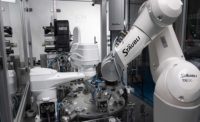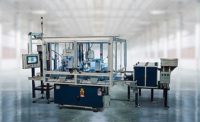At the start of the COVID-19 pandemic, the healthcare industry faced a large-scale shortage of personal protective equipment (PPE), which put frontline workers at risk of infection. Wanting to help, machine builder and contract manufacturer Harbour Technologies Ltd. of Windsor, ON, designed and built a robotic cell to swiftly manufacture FDA-approved Level 2 and Level 3 isolation gowns, which helped the Canadian government provide more PPE to hospitals across the country. The cell was so successful that Harbour Technologies hopes to provide PPE not just to Canada—but to the rest of the world.
“It’s tremendously important for Canada to have resilience in manufacturing PPE,” says Andrew Glover, co-owner of Harbour Technologies. “We saw it -firsthand in the beginning of the pandemic, when there was a shortage of PPE across North America, especially in Canada.”
Harbour Technologies is a third-generation, family-run company with more than 45 years of manufacturing experience. The company specializes in custom machine tools, high-tolerance tools, machining, and assembled components for the nuclear, oil and gas, aerospace, and automotive industries.
Designing and building a robotic cell to make PPE would not be easy. To keep healthcare workers safe, the FDA has extremely high standards for manufacturing Level 3 isolation gowns. According to the FDA, all areas of the surgical isolation gown except bindings, cuffs, and hems are considered critical zones of protection and must meet the highest liquid barrier protection level for which the gown is rated. As a result, quality control would be crucial for the cell.
“We found there was a lot of PPE that was substandard and put our frontline workers at risk,” Andrew recalls. “With our robotic gown system, the quality is far superior than anything that is made manually.”
At the same time, the cell would need to be intuitive to operate and easy to use. “We wanted to make sure that when an operator hits start on the machine, it does what it needs to do,” says David Glover, co-owner of Harbour. The company wanted anyone to be able to operate the machine with minimal training.
Harbour’s system can produce 3,000 gowns per day. It can run various materials, including spunbond meltblown spunbond (SMS), polyethylene terephthalate (PET), and washable materials. The system can run different size gowns at once, or a mixture of batches. For example, it can produce batches of mediums and larges at the same time.
To start, large rolls of the gown material are loaded into the cell. Servo-controlled rollers release the exact amount of material needed to produce one gown, and they can be adjusted on the fly to accommodate different products.
Once the tabletop workspace is covered in material, a six-axis robot uses a tool-changing station to equip itself with a proprietary rotary ultrasonic welding horn designed by Harbour Technologies. Using this tool, the robot traces the gown pro-file to bond the front and back pieces of material together. The tool produces a three-bar welded seam that ensures that no fluids can penetrate the gown. The ultrasonic welder itself was provided by Telsonic Ultrasonics Inc.
Next, the robot returns to the tool-changing station and automatically swaps the welding tool for a knife. The robot uses the knife to cut the material in the shape of the gowns or any accessories, such as neck ties or waistbands. Then, the robot changes tools a third time to a gripper, which picks up the completed gown and sets it aside for packing. The gowns are then manually packed for distribution by Harbour employees.
The system uses a Kawasaki RS050N robot, which has a 2,100-millimeter reach and can carry a 50-kilogram payload. To get the right robot for its application, Harbour Technologies met with Kawasaki’s engineering team to discuss the intricacies of the application.
“We sat with their engineering team, gave them our requirements, and worked together to select the proper robot and platform,” says David Glover.
From a manufacturing standpoint, automating the gown-assembly process provided numerous advantages. First, the cell makes it possible to increase production signifi-cantly while reducing labor costs.
“There are multiple benefits to being able to make the gown 100 percent complete in a robotic system,” says Andrew Glover. “Not just in the savings on labor, but in cycle time. We are able to produce a gown a lot faster than what’s being made manually.”
On a larger scale, this cell opens up Harbour Technologies’ business, allowing the company to lay the groundwork to become a global competitor as a manufacturer of PPE. Harbour plans to continue PPE manufacturing in house, and it will sell this system to other Canadian businesses as a part of their reshoring efforts.
Thanks to the success of the robotic PPE manufacturing cell, Harbour has created hundreds of jobs in the community.
“There was never PPE manufacturing in Canada at this level. With the robotic systems, it allows us to compete globally, which therefore creates jobs locally that were never there before,” says Andrew Glover. “Throughout Ontario, our production cells are employing more than 600 people, and that’s something that was never there prior to the pandemic. Robots have allowed us to continue creating these jobs and continue growing in this market.”
Harbour has also designed and built automated systems to produce N95 masks and three-ply surgical masks.
For more information on robotic assembly cells or contract manufacturing, call Harbour at 519-969-0641 or visit https://harbour-tech.com.
For more information on robots, call 248-446-4100 or visit www.kawasakirobotics.com.
For more information on ultrasonic welding technology, call 586-802-0033 or visit www.telsonic.com.
Editor’s note: Whether you’re a systems integrator or the in-house automation team of an OEM, if you’ve designed a system that you’re particularly proud of, tell us about it. Send an e-mail to John Sprovieri, chief editor of ASSEMBLY, at sprovierij@bnpmedia.com, or call 630-776-0924.







